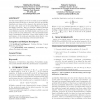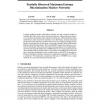ICMLA
2010
14 years 5 months ago
2010
Markov Logic Networks (MLNs) combine Markov Networks and first-order logic by attaching weights to firstorder formulas and viewing them as templates for features of Markov Networks...
GECCO
2008
Springer
14 years 8 months ago
2008
Springer
The key ideas behind most of the recently proposed Markov networks based EDAs were to factorise the joint probability distribution in terms of the cliques in the undirected graph....
AAAI
1990
14 years 8 months ago
1990
The probabilistic network technology is a knowledgebased technique which focuses on reasoning under uncertainty. Because of its well defined semantics and solid theoretical founda...
NIPS
1997
14 years 8 months ago
1997
We address the problem of learning structure in nonlinear Markov networks with continuous variables. This can be viewed as non-Gaussian multidimensional density estimation exploit...
NIPS
2008
14 years 8 months ago
2008
Learning graphical models with hidden variables can offer semantic insights to complex data and lead to salient structured predictors without relying on expensive, sometime unatta...
GECCO
2007
Springer
15 years 1 months ago
2007
Springer
Markov Networks (also known as Markov Random Fields) have been proposed as a new approach to probabilistic modelling in Estimation of Distribution Algorithms (EDAs). An EDA employ...
ICML
2005
IEEE
15 years 8 months ago
2005
IEEE
Markov logic networks (MLNs) combine logic and probability by attaching weights to first-order clauses, and viewing these as templates for features of Markov networks. In this pap...
ICML
2007
IEEE
15 years 8 months ago
2007
IEEE
Markov logic networks (MLNs) are a statistical relational model that consists of weighted firstorder clauses and generalizes first-order logic and Markov networks. The current sta...






